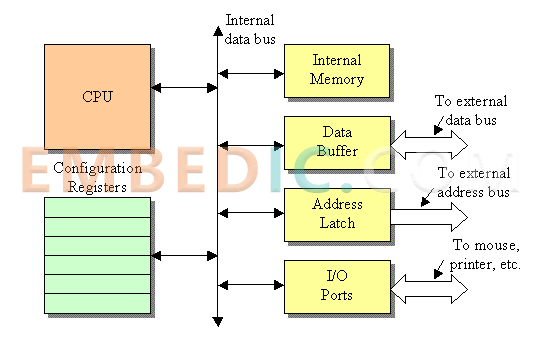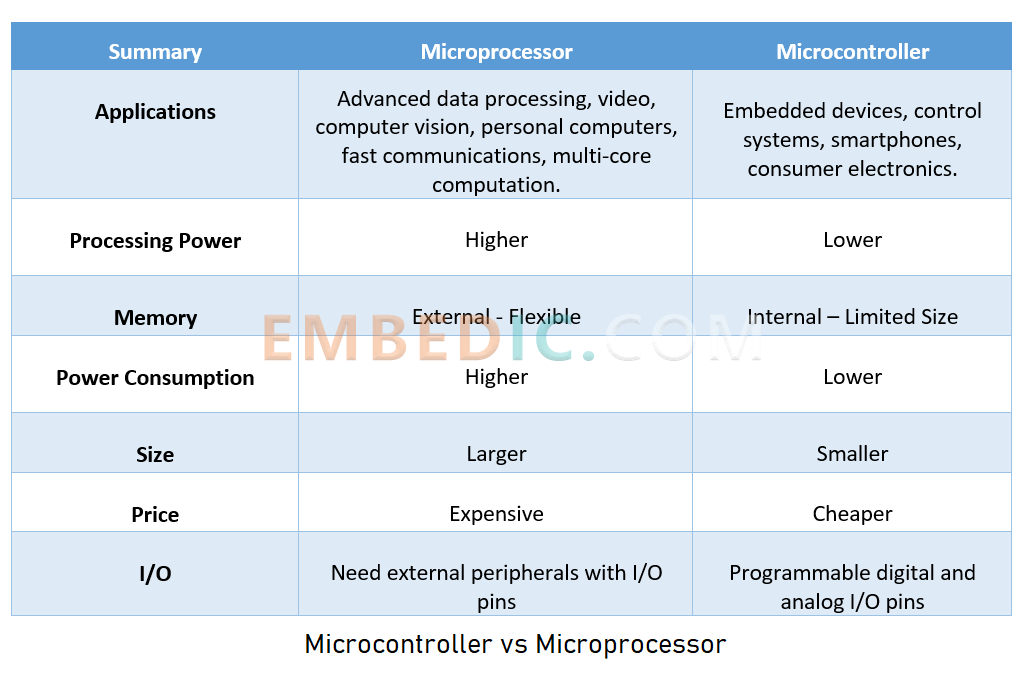Have you wondered what the microprocessor is? The microcontroller and microprocessor is similar but they are totally different, today our team will clear everything about it, let's read on.
Microprocessor is a central processing unit made up of one or a couple of large-scale integrated circuits. These circuits carry out the functions of control parts and also arithmetic logic components.
The microprocessor can complete operations such as fetching instructions, executing instructions, and exchanging information with external memory and logic components, and is the operation control part of the microcomputer. It can create a microcomputer with memory as well as peripheral circuit chips.
The microprocessor consists of arithmetic logic unit (ALU, Arithmetic Logical Unit); accumulator and general register set; program counter (also called instruction pointer); timing and control logic components; data and address latches/buffers; internal bus composition. Among them, the arithmetic unit and the controller are its main components.
The most basic functional structure of a microprocessor consists of an operator, a controller, a register set and an internal bus.
The figure gives the internal structure diagram of an 8-bit microprocessor, which includes: operator, register group (which includes: accumulator, status register, program counter and other functional register groups), instruction hosting decoder, address register, data buffer, internal data bus, external leads (including: address signal line, data signal line, control/status signal line), etc. Each part plays a different role in the microprocessor.

(1) Operator: It is a component that performs operations. It can complete addition, subtraction, multiplication, division, AND, OR, NOT, XOR, and shift under the action of control signals, so it is also called an arithmetic logic unit.
(2) Register group: It is used to speed up the operation and processing speed, temporarily store the data involved in the operation or the intermediate result of the operation, which is a very important part of the microprocessor. The register set includes:
(3) Internal data bus: It is a data transmission channel between various parts within the microprocessor, and it is bidirectional. The width of its bus determines the number of bits for data transfer within the microprocessor.
(4) Instruction register decoder: It consists of instruction register (IR), instruction decoder (ID) and control logic (PLA), which is the control command center of the entire microprocessor. The CPU fetches the instructions from the external memory through the bus and temporarily stores them in the IR. Analyze and interpret the instructions in the IR, and generate corresponding control signals through the control logic (PLA) to coordinate the orderly work of the entire computer.
(5) Address register: It is used to register the address to be sent by the CPU to the outside, and its content source can be the program counter or the internal bus. It outputs the address to a memory or I/O interface other than the CPU.
(6) Data buffer: It plays the role of buffering data transmission inside and outside the CPU. Only when the CPU allows data transmission, the door of the buffer will be opened. It's 8-bit for an 8-bit machine, and 16-bit for a 16-bit machine.
(7) Data signal line (DB): The channel for data transmission between CPU and memory or I/O interface, and its width determines the number of bits of data transmitted between CPU and external memory or I/O interface.
(8) Address signal line (AB): It is the channel for the CPU to provide address information, and its width determines the external addressing range of the CPU.
(9) Control N/status signal line: a channel used to transmit control or status signals, such as providing read signals, write signals, memory strobe signals, I/O interface strobe signals, etc., and can also receive clock signals, etc.
With the development of technology and the enhancement of microprocessor functions, in addition to the above basic parts, memory management components, cache components, etc. will be added inside the microprocessor.
The work process of the microprocessor is the process of executing the program, and the execution of the program is the step-by-step execution of an instruction over the microprocessor can only recognize the machine instructions, you need to use a variety of compilers will be prepared by the high-level programming language program to machine instructions constitute the program. Microprocessor in the execution of an instruction, the main steps to complete the following.
Fetch instruction: The controller sends a message to fetch an instruction from memory.
Instruction decoding: The instruction decoder translates the acquired instruction into a microinstruction that plays a control role.
Fetch operand: If an operand is required, the operand of the instruction is fetched from the memory.
Execute the operation: The CPU completes the specified operation on the operand by executing the micro-instruction as required by the instruction opcode.
Send back the result: The result of the execution of the instruction is sent back to the memory or to a register.
The operation of the microprocessor is periodic, i.e., fetching instruction, instruction decoding, fetching operand, and then fetching instruction. This series of operation steps is carried out precisely according to the timing sequence, so the microprocessor needs a timing circuit. The timing circuit is controlled by a standard oscillation pulse signal generated by a crystal oscillation circuit, and once the machine is powered up, the timing circuit sends out a clock signal continuously.
Watch the video about how the microprocessor works.
(1) Small size, low power consumption
(2) high reliability, low requirements for the use of the environment
Due to the use of large-scale integrated circuits and ultra-large-scale integrated circuits, external wiring and external logic is simplified, easy to install, greatly improving the reliability.
(3) Flexible system design, easy to use
Now the microprocessor chip and its corresponding support logic are standardized and serialized products, users can constitute a different scale of the system according to different requirements.
(1) According to the microprocessor bit classification: bit chip, 4-bit, 8-bit, 12-bit, 16-bit, 32-bit, 64-bit and other microprocessors.
(2) According to the classification of microprocessor applications are: general-purpose high-performance microprocessors, embedded microprocessors, digital signal processors and microcontrollers.
Generally speaking, general-purpose processors pursue high performance, they are used to run general-purpose software, equipped with a complete and complex operating system; embedded microprocessors emphasize high performance in dealing with specific application problems, mainly used to run special programs for specific areas, equipped with lightweight operating systems, mainly for cellular phones, CD players and other consumer appliances; microcontrollers are relatively low-priced, in the microprocessor market The demand is the highest in the microprocessor market, mainly used in automobiles, air conditioners, automatic machinery and other fields of self-control equipment.
The differences between microprocessors and microcontrollers are mainly focused on 3 aspects: hardware structure, application area and instruction set characteristics.

A microprocessor is a single-chip CPU, while a microcontroller integrates the CPU and other circuits in an integrated circuit chip to form a complete microcomputer system. In addition to the CPU, the microcontroller also includes RAM, ROM, a serial interface, a parallel interface, timers and interrupt scheduling circuits. All of these are integrated on a single integrated circuit. Although the capacity of the on-chip RAM is smaller than that of an ordinary microcomputer system, this does not limit the use of the microcontroller. As you will learn later, microcontrollers have a wide range of applications.
The built-in interrupt system is an important feature of microcontrollers. As a control-oriented device, microcontrollers often have to respond to external stimuli (interrupts) in real time. The microcontroller must perform a fast context switch, suspending one process to execute another in response to an "event". For example, opening the door of a microwave oven is an event that would trigger an interrupt in a microcontroller-based product. Microprocessors can also have powerful interrupt functions, but usually require external components, while microcontrollers have all the necessary circuitry to handle interrupts integrated on-chip.
Microprocessors are often used as the CPU in microcomputer systems. They are designed for such applications, and this is where microprocessors excel. However, microcontrollers are usually used for control-oriented applications. Their system design seeks to be miniaturized and to reduce the number of components as much as possible. In the past, these applications usually required dozens or even hundreds of digital integrated circuits to be implemented.
Using a microcontroller reduces the number of components used and enables the same functionality with only a microcontroller, a small number of external components and a control program stored in ROM. Microcontrollers are suitable for those applications where control of input/output devices is achieved with very few components, while microprocessors are suitable for information processing in computer systems.
You may like: [2022] The Important Role of Microcontrollers in Appliances
The instruction sets of microcontrollers and microprocessors differ due to the different applications. The instruction set of the microprocessor enhances the processing functions and gives it a powerful addressing mode and instructions suitable for manipulating large-scale data. Microprocessor instructions can operate on half bytes, bytes, words, and even double words. Through the use of address pointers and address offsets, the microprocessor provides addressing modes that allow access to large amounts of data. Self-incrementing and self-decrementing modes make it easy to access data in bytes, words, or double words. In addition, the microprocessor has other features, such as the inability to use privileged instructions in user programs.
The guideline set of the microcontroller is suitable for input/output control. Many input/output interfaces are single/bit. For example, a solenoid controls the switching of a motor, and the solenoid is controlled by a 1-bit output port. Microcontrollers have instructions to set and clear units, and can also perform other bit-oriented operations, such as logical with, or, and different or operations on "bits", jumps based on flag bits, etc. Few microprocessors have these powerful functions. Few microprocessors have these powerful bit manipulation capabilities because designers design microprocessors with only bytes or larger units of data to manipulate in mind.
For control and monitoring of devices (possibly through a 1-bit interface), microcontrollers have specialized internal circuitry and instructions for input/output, timing, and priority assignment for external interrupts. Microprocessors generally need to be coupled with additional circuitry (serial interface chip, interrupt controller, timer, etc.) in order to perform the same tasks. However, purely in terms of processing power, microcontrollers never reach the level of microprocessors (all other things being equal) because a large portion of the integrated circuits in a microcontroller chip are used to implement other on-chip functions at the expense of some of the processing power.
Since the resources on the microcontroller chip are very tight, its instructions must be very lean, with most instructions shorter than 1 byte in length. The design principle for control programs usually requires that the program fit into an on-chip ROM, since adding even just one external ROM will significantly increase the hardware cost of the product. The standard feature of the microcontroller instruction set is that it has a streamlined coding scheme. Microprocessors do not have such a feature because their powerful addressing modes make the instruction coding not concise enough.
Manufacturer: Texas Instruments
IC DGTL MEDIA SOC 337NFBGA
Product Categories: SOC
Lifecycle:
RoHS:
Manufacturer: Texas Instruments
IC DGTL MEDIA SOC 337NFBGA
Product Categories: SOC
Lifecycle:
RoHS:
Manufacturer: Texas Instruments
IC DSP FIX/FLOAT POINT 841FCBGA
Product Categories: DSP
Lifecycle:
RoHS:
Manufacturer: Texas Instruments
IC DSP/ARM PROCESSOR 1031FCBGA
Product Categories: DSP
Lifecycle:
RoHS:
Looking forward to your comment
Comment